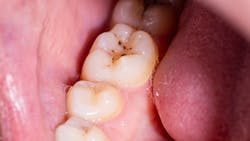ADA's new tooth decay treatment guideline advises conservative approaches
In a first, the American Dental Association (ADA) has released a clinical practice guideline on the treatment of tooth decay in primary and permanent teeth recommending, overarchingly, that conservative treatments could lead to better outcomes when used with common restorative materials.
Published in Journal of the American Dental Association (JADA), the report, Evidence-based clinical practice guideline on restorative treatments for caries lesions, was developed by an expert panel and contains 16 recommendations about treatment of moderate and advanced tooth decay in primary and permanent teeth that have not received endodontic treatment.
The recommendations and good practice statements include four on CTR approaches specific to lesion depth and 12 on direct restorative materials specific to tooth location and surfaces involved. The panel conditionally recommended for the use of conservative CTR approaches, especially for advanced lesions, and for the use of all direct restorative materials, prioritizing some materials over others for certain clinical scenarios.
The report indicates conservative carious tissue removal (CTR)—removal of infected tissue while preserving as much of the original tooth structure as possible—is "less likely to result in adverse outcomes such as nerve exposure or a failed filling."
According to the ADA’s press release on the report, the recommendations also identify selective CTR—which involves removing most, but not all, decayed tissue before sealing the tooth with a filling or cap—as an effective treatment option in most cases of moderate or advanced decay in primary and permanent teeth. The bacteria left behind under the new filling or cap can no longer multiply, which stops tooth decay.
The guideline also affirms the efficacy of the most common restorative materials for treating moderate or advanced tooth decay, such as tooth-colored fillings, amalgam fillings, or preformed caps in children. It suggests specific materials for primary and permanent teeth depending on the extent of the decay.
In the press release, lead report author Vineet Dhar, BDS, PhD, MPS, clinical professor and chair of orthodontics and pediatric dentistry at the University of Maryland School of Dentistry and a member of the ADA Council on Scientific Affairs, said the recommendation encapsulates the two main objectives of restorative dentistry: maintaining healthy tooth structure and protecting soft tissue.
“While research had already confirmed that selectively removing decayed tissue is an effective approach to treating early tooth decay, dentists needed an evidence-based guideline to provide them with a range of treatment choices for patients with moderate to advanced tooth decay,” he said. “These recommendations can now inform restorative care strategies in the US and on a global level.”
David Rice, DDS, chief editor of DentistryIQ, said he feels the new recommendations will be a valuable tool in improving outcomes:
"I’m very excited to read the ADA’s newest guidelines on the preservation of tooth structure," he said. "The data and shift to an even more conservative approach is an incredible step toward better health for patients."
Sourced primarily from the ADA press release: American Dental Association Releases New Tooth Decay Treatment Guideline
Access the full report on JADA: Evidence-based clinical practice guideline on restorative treatments for caries lesions
About the Author
Elizabeth S. Leaver
Digital content manager
Elizabeth S. Leaver was the digital content manager for Endeavor Business Media's dental group from 2021-2024. She has a degree in journalism from Northeastern University in Boston and many years of experience working in niche industries specializing in creating content, editing, content marketing, and publishing digital and magazine content. She lives in the Boston area.
